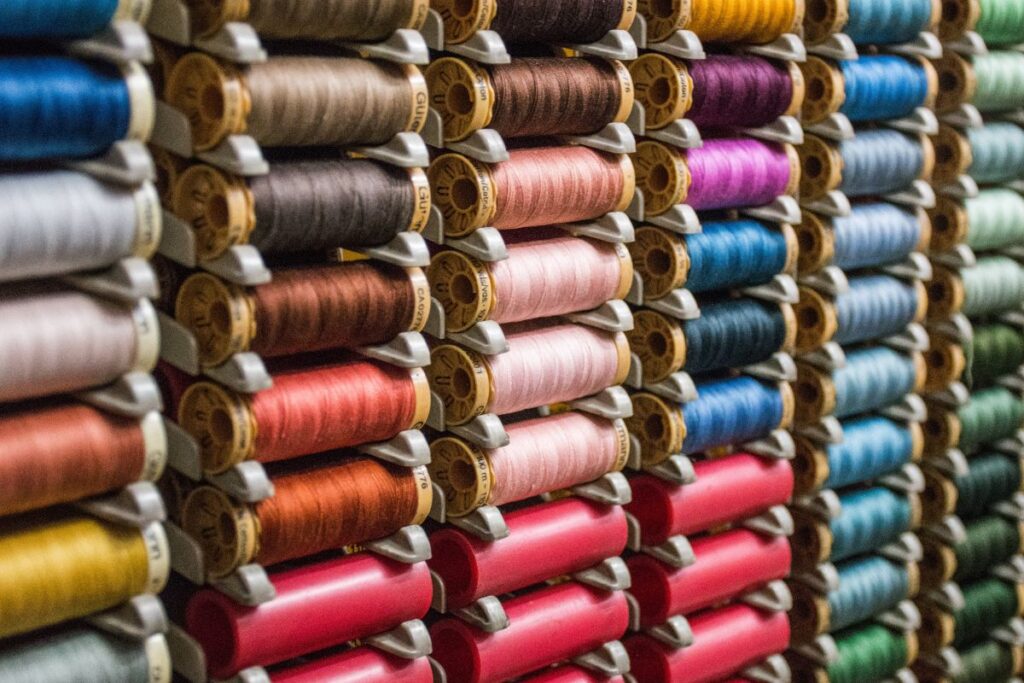As a major polluter, the fashion industry is largely to blame for the widespread usage of toxic goods like polythene terephthalate in clothing production (PET). The potential for recycling PET to aid the manufacturing sector in cutting carbon emissions remains unproven. A new study in the Journal of a American Chemical Society found that recycled PET or some other plastics combined with tomato peel additives improved in both durability and thermal stability. It is hoped that this discovery would result in less polluting procedures for making recycled clothing, which will contribute to the reduction of carbon emissions associated with manufacturing.
Many companies now make use of PET bottles that have already been recycled to lessen their negative effects on the environment. But this doesn't solve the fashion industry's biggest problem—the widespread availability of low-quality, fast-fashion items—so it may not be good news for the sector as a whole. Carbon dioxide emissions from new textile manufacture and transportation can be reduced through recycling, but this doesn't address the larger issue of the enormous amounts of textiles and clothes that are used and then discarded every year.
It would be ideal if recycling were combined with efforts to reduce consumption. One way people can reduce their impact on the environment is by recycling at least half of the clothing they buy each year and buying only what they need (no fast fashion or disposable clothing). This way, we can make progress on both fronts at once instead of just one.
Using recycled PET inside the clothing business is not a sustainable practise. The environmental impact of this recovered plastic is the same as that of virgin plastic. The rate at which substances like PET can be recycled and reused can never match the amount of new polymers are being used, but we must all do whatever we can to lessen our environmental effect through recycling. Many individuals nowadays feel that recycling alone will be enough to make a difference in their life, and that this is a short-sighted view.
Recycling alone won't solve the world's garment production and consumption trash concerns entirely. Also, although recycling does significantly cut down on waste at first, supplies of recyclable materials run out with demand for worn goods drops.
Many individuals mistakenly believe that recycling Glass bottles is beneficial to the environment; this piece will show why that is not the case.
Although recycling as a practise has exploded in in recent years, not everything can be recycled or reused in a similar way. The plastic used to make the vast majority of plastic water and soda bottles, polythene terephthalate (PET), is one of the recyclables that causes the most trouble.
Only 6% of the PET used in U.S. factories each year comes from recycled sources. To be recycled effectively, PET plastics must be deformed and so cannot be recycled.
The textile sector generates about 80 tonnes of garbage every year, yet only 15% of that material is actually collected and transported to recycling facilities. The sustainability crisis in the fashion industry cannot be solved by using recycled polyamide terephthalate (PET) fabric.
This is just another way that polluting industries can continue to operate without sharing any of the responsibility for the damage they cause. Here, we'll examine the many instances in which recycled PET fabric exacerbates the problem without ameliorating it. Let's start the celebration now.
FAQs About Pet
The huge environmental benefit of recycling is that fewer virgin raw materials are needed for the manufacturing of new products. Furthermore, recycling reduces pollution that is caused by discarding or burning waste. This is why recycling has become an integral part of many companies' sustainability strategy.
Products commonly made from recycled PET include new PET bottles and jars, carpet, clothing, industrial strapping, rope, automotive parts, fiberfill for winter jackets and sleeping bags, construction materials, and protective packaging.
Because PET is fully recyclable, it's a highly sustainable material. Every time a PET container is recycled, its petroleum feedstocks can be recaptured and reused. The "lightweighting" of PET containers has also resulted in reducing the average weight of the 0.5 liter PET bottle by 48% in the past ten years.
You can make both PE (polyethylene) and PET plastics from plant materials. These are the same as the products made from petrochemicals and can be recycled in the same way. Although made from plants these are not biodegradable. A biodegradable plastic is one that will biodegrade.
The product lifecycle is continuous and doesn't lead to plastic waste. PET plastic is a sustainable packaging solution with a lower carbon footprint than other plastics. PET requires less energy to produce than new plastics. This can help suppliers and manufacturers save money and reduce their energy consumption.
First And Foremost, What Exactly Is Recycled Polyester?
The fibre is made from rPET, which stands for recycled polythene terephthalate. The main difference between rPET and non-recycled PET is that the latter employs virgin material while the former uses recycled. Polyester, an plastic polymer, could be smelted and reshaped into forms repetitively without losing its strength or durability thanks to its thermoplasticity.
Material used in construction projects is a prime candidate for recycling infrastructure, and manufacturers have taken notice. A variety of stores, ranging from Boutique to Zara, have already started including it in their online and print catalogues. Some companies like Inditex, Adidas, or Umbro may have pledged to completely switch from using virgin polyester to using recycled polyester by a specified date. (That year will be 2025 for Inditex and its subsidiaries like Zara; 2024 for Adidas and Reebok.)
Recycled Pet Is Not Sustainable In Fashion
Polythene, a type of plastic made from petroleum, is gaining popularity as a viable alternative to polyester due to the latter's negative effects on the environment. Because of this, many businesses and retail establishments now advocate for polyester as a greener alternative. They claim that sustainable retail giants like American Eagle, Marine Layers, and Inditex are using recycled polyester in their products. Similarly, Gap Inc.—the parent company of a Gap, Old Navy, Adidas, Intermix, & Banana Republic labels—is a leader in the fashion industry. Companies like Patagonia and Outdoor Voices, which are both leaders in their respective fields, are not exempt to this issue.
In the fashion industry, the cloth has come to symbolise "sustainable" methods of production and consumption. The question is, how much of an improvement can recycled polyester really make in terms of environmental impact? Fiber production from recycled plastic bottles is not a new idea. Since the 1990s, a few shaky mills and companies have already been striving for its widespread adoption. Nonetheless, recycled PET has only lately get to be a popular and frequently used material that can be considered a sustainable option to polyester.
It all began with G-Star Rough and their Raw Again for Oceans campaign and has now expanded to include Nike, H&M, Adidas, Stella McCartney, and many more. Everything from strollers to evening gowns may be made from plastic that has been recycled.
What can be better than turning a PET bottle into a stylish new piece of clothing? Bionic Yarn's project to repurpose microplastics in manufacture is gaining traction because it is accompanied by engaging speeches about cleaning up the ocean, like the one given by pop artist Pharrel Williams.
Let's not try to gloss over the truth here; honesty is required. The idea of trash outnumbering fish in the sea is revolting. Having someone else deal with the trash while providing us with "ecological sustainability" in the shape of things we were going to purchase anyhow is a welcome relief. The materials used in the creation of both my sneakers nor my jeans are ocean trash recycled from the sea.
Isn’t that amazing ?!
Where Things Get Difficult
The entire lifespan cycle of rPET-based apparel reveals a great deal of nuanced intricacy. For instance, rPET apparel can be manufactured from either textile waste or plastic waste, such as that collected from recycled water bottles.
Understanding the full cycle of rPET-based clothing's existence reveals several hidden complexities. For instance, rPET clothing may be manufactured from either textile waste or plastic waste, such as that collected from recycled water bottles.
The textile recycling industry is "in its infancy," according to the technology behind textile recycling, which states that "just 1 percent of all apparel gets recycled." In the long run, this makes it far less appealing to recycle rPET clothing.
Producing rPET is undeniably more environmentally friendly than producing virgin PET, but that has nothing to do with the current issue. More importantly, it's because the item will be thrown away after being used by the second consumer.
Mechanical recycling is the norm today. According to Francois Souchet of a Ellen MacArthur Foundation, "the principal application of this technique is to convert plastic bottles into garments." Bottles that have been turned into garments cannot be recycled at the present time.
Due to the restricted textile-to-textile recycling capacity, we have tiny diameter, or no recourse, to complete the loop and recycle rPET clothes continually, which means the beneficial impacts of rPET are often overstated, especially by firms looking to profit from eco-conscious consumers.
How Recycled Polyester Harms The Environment
Reducing the quantity of plastic debris that ends up in the oceans or other water bodies would be an admirable and respectable goal (necessary, in fact). While recycling is admirable in principle, the mechanical recycling industry that turns plastic water bottles into rPET clothes undermines the entire concept. Although less energy is used and fewer glasshouse gases are produced during production of rPET compared to virgin PET, its end-of-life characteristics are otherwise indistinguishable from those of other non-recyclables you might toss away. As a result of its lengthy stay in landfills, its biodegradation rate is slower than that of a glacier.
When seen through the prism of a challenge shared by all textiles, the shortcomings of rPET become clearer. loss of microfibers. The washing procedure removes tiny particles from all fabrics. However, the dangers posed by synthetic fibres like those found in polyester are significantly higher. These pieces of synthetic trash are known as "fibrous microplastics" in scientific circles, a name that sounds awful even before considering the harm they do to marine ecosystems.
The risk presented by these microfiber cloths, which shed inside the wash and wind up in the seas and other bodies of water, has been demonstrated by numerous studies on the prevalence of microplastic particles within fish and sea life.
Additionally, there is worry that chemicals used during the production of plastics have entered marine ecosystems as a result of the flow of plastics into in the environment, an issue that will persist even if the original artificial fabric is recycled.
It Appears That We Must Discuss Microplastics. Again. Over And Over Again.
There are two major sustainability-related arguments in favour of employing recycled plastic instead of polyester. The most obvious advantage is the ability to turn garbage into something useful. By itself, recycling is a positive act. The general public thinks that recycling should always be the first option. Second, it is well known that recycling lessens or even eliminates the requirement to collect virgin raw resources, in this case, non-renewable polyester, in order to manufacture new goods.
However, the presence of micro - plastics in fully recyclable fabrics cannot be ignored; the recycling process is defective (as we shall see), and elevated fibres necessitate the inclusion of fresh raw material. Plastic fabric particles can be released regardless of the weft or yarn structure. More plastic particles will break away from the wires when the water temperature and friction are raised.
Unfortunately, some of these microplastics are not removed from the sewage system before being released back into the ocean. Fish mistake these for food and absorb them whole, introducing the toxins into the food chain.
As stated in A New Textile Economy, a paper on that circular economy authored by the Ellen Macarthur Foundation, 500 thousand tonnes of nanoplastics from plastic clothes are disposed of in the oceans every year. The equivalent of fifty billion water bottles. "In this trajectory," the paper states, "the amount of urethane plastic entering the waters between 2015 and 2050 might reach 22 million tonnes." This is roughly a multiplication of the number of synthetic materials used in garment production in a year.
Taking plastic from the seas (or elsewhere) to make clothing is counterproductive since the microplastics released into the water and sewage systems are not filtered. This poses a threat to marine life and, by consequence, human health. The correct response is "no," because there is zero gain. The plastic we remove from the environment must be used to create items that can be recycled repeatedly. The topic of discussion then changes.
In This Process, There Is No Circular Economy; Instead, There Is An Interrupted Cycle.
Companies that use "circular economy" participants who actively gather recycled plastic. In contrast, in a circular economy, any recycled, reused, but more often composted product always produces a new product having the same or more value than the one it replaced. To the contrary, plastic fabrics are never recycled once they have outlived their usefulness, regardless of whether or not they were made from previously recycled materials. Most textiles that have been used once by consumers end up in landfills since there is no currently viable way for recycling them on a massive scale.
A PET bottle, for instance, can be continually recycled into new Containers or other plastic products, but when it is transformed into a cloth with no other use than the garbage, the cycle is broken. This school of thinking posits that brands exacerbate the waste problem in the soft drink industry by reusing components from that industry.
So they may talk a good game about sustainability while doing little to kerb the massive amounts of plastic waste produced by the beverage industry, despite the reality that 60 textile trucks' worth of material are discarded in landfills every minute. This is why implementing a closed-loop economy through the utilization of recycled PET with in fashion sector is controversial.
According to the Greenpeace study "Fashion at the Crossroads," initiatives such as these "can at best be understood as a way of communicating to enhance public consciousness of plastic trash in the oceans," but they "cannot be considered a serious step towards circularity."
Real Solutions Are Impossible To Find In One's Comfort Zone.
Recycling plastics has many benefits. It helps industries or people settle into routines, thus it's not a resolution so much as a barrier to discovering a better one. Businesses that adopt the practise of using reusable bags from unrelated sectors are less likely to consider innovative strategies that reduce this same density of goods and prolong product life; they are also less likely to address the issue of microplastics; they are less likely to invest in the development of fiber composites that can have a positive effect; they are less likely to manage their own waste or the waste of others.
Their packaging being ignored by the food industry gives the appearance that they are addressing an issue for which they are neither accountable or capable of providing a solution. In a single year, the major soda companies produce almost fifty billion PET bottles. If a fashion company can't handle its own trash, it's ridiculous to expect them to recycle it.
Brands continue to contribute to the waste produced by the ou pas beverage sector without addressing the underlying source of the problem.
Moreover, as the need for virgin plastic rises, so does the use of recycled plastic. The quantity of trashed plastic also increases. Is this post-consumer recycled plastic, then?
And if employing recycled PET in garments doesn't reduce overall plastic consumption and waste, what's the point? The 322 million tonnes of plastic made in 2015 is expected to have quadrupled by 2025.
So, What Are Your Options?
Since there is no way to eliminate the need for synthetic materials in clothing, an open and frank discussion about these elements is essential. Furthermore, bioplastics should be an alternative for plastic-using products such as athletics, things, and elastane products.
In order to build a closed loop and find a purpose for all of the waste viscose, nylon, spandex, and ripstop nylon produced by the industry, this recycled plastic must be sourced from within the sector. To avoid unintentionally creating monstrous hybrids, textiles should be designed and manufactured without the use of any additional fibres, particularly virgin ones. In addition, they are designed so that shoes and bags, for example, don't become ruined by excessive washing or soaking and use technology to minimise the unravelling of plastic particles while cleaning.
In addition to launching reverse logistics projects, businesses will need to devote resources to R&D. So that not only will this fully recyclable garment not contribute to pollution or landfill overcrowding, but also that businesses can secure a more sustainable future by cutting back on the amount of raw materials they use and the amount of virgin plastic they incorporate into their production processes, we present you with this garment. It's hard to conceive about, but it's not impossible. Patagonia and Houdini are just two brands that have begun this practise.
Switching towards organic cotton and advocating for the use of alternative fibres like linen is important for a number of reasons, including the use of sustainable manufacturing methods, a longer service lifespan, and consumer comfort.
Is It Appropriate For Businesses To Use Recycled Polyester?
It's not that reusing plastic water bottles isn't a good idea for commercial enterprises. However, it has been pointed out that making recycled material from non-recycled fossil fuels is significantly more damaging to the environment. This suggests that rPET is neither a practical or sufficient target for the redesign of the clothing industry at this time.
rPET material sourcing strategy Companies should examine and analyse the impacts of synthetic material shed on marine environments before patting themselves on the back on their sustainable ideals. Before rPET to be regarded a truly green alternative, more cautious closed-loop procurement practises and a large increase in fabrics recycling are needed.
The Achilles Heel Is In The Logic, Not The Products Or Processes.
Making fashionable items out of trashed plastic is a buzzworthy idea. The existing fashion marketing strategy (selling increasingly more) is the elephant inside the room that must be addressed before any truly new approaches to sustainability can be developed.
Businesses that have been doing so for years include Patagonia or Filippa K of Sweden, but many smaller companies offer the same perks, such as a lifetime guarantee, reverse logistics, and unlimited recycling. If we do not make progress and settle for less, the industry will remain as it is and plastic will continue to accumulate in the coral reefs. Recycling plastic into new clothing would not help either the environment or the fashion industry. The only people and organisations that will succeed are the ones who are prepared for genuine transformation.
Conclusion
Recycled PET or other plastics coupled with tomato peel additives increased durability and thermal stability, according to a new study published in the Journal of the American Chemical Society. The fashion sector is a major contributor to environmental pollution. While this research may pave the way for cleaner methods of recycling textiles, it still won't address the fashion industry's underlying problem with cheap, disposable apparel. People can lessen their influence on the planet by buying only what they need and recycling at least half of the clothing they purchase each year.
Even though recycling has become increasingly popular in recent years, not all materials are amenable to being reused or recycled in the same way. One of the most problematic recyclables is polythene terephthalate (PET), which is used to create the great majority of plastic water and soda bottles, but just 6% of the PET used in U.S. companies originates from recycled sources. In order to be recycled properly, PET polymers need to be distorted, making recycling them impossible. Some 80 tonnes of waste is produced annually in the textile industry, but only 15 percent of that is actually collected and sent to recycling plants. The use of recycled PET fabric just makes matters worse.
Content Summary
- The widespread use of harmful materials like polythene terephthalate in clothing production can be traced back to the fashion industry, which is a major polluter (PET).
- It is still unclear whether or not recycling PET may help the manufacturing sector minimise carbon emissions.
- When recycled PET or other polymers were mixed with additives made from tomato peels, the results were published in the Journal of the American Chemical Society.
- With any luck, this finding will lead to less polluting methods for producing recycled apparel, which in turn will aid in lowering manufacturing-related carbon emissions.
- To decrease their environmental impact, several businesses are switching to recycled PET bottles.
- Yet, the widespread availability of cheap, fast-fashion items means that this may not be good news for the fashion industry as a whole.
- Though recycling helps cut down on the carbon dioxide produced during the creation and delivery of new textiles, it does little to solve the problem of the massive amounts of these materials being used and then thrown away every year.
- Combining recycling with campaigns to reduce consumption is preferable.
- One method individuals can lessen their environmental impact is by recycling at least fifty percent of the clothing they purchase annually and limiting their clothing purchases to necessities only (no fast fashion or disposable clothing).
- We must all do all we can to decrease our environmental impact through recycling, even though the rate at which substances like PET can be recovered and reused will never match the number of new polymers being consumed.
- Unfortunately, many people today have a myopic view of the world, believing that they can improve their lot in life just by recycling more.
- It is clear that recycling alone will not end the world's garbage problem caused by the manufacture and use of clothing.
- Also, although recycling does initially dramatically reduce trash, supply of recyclable materials run short as demand for used goods lowers.
- This article will dispel the common misconception that recycling glass bottles is good for the environment.
- Reusing and recycling have become increasingly popular in recent years, but not all materials respond in kind.
- Polythene terephthalate (PET), the plastic used to create the great majority of plastic water and drink bottles, is one of the most problematic recyclables.
- Each year, just 6% of the PET used in U.S. manufacturing originates from recycled materials.
- In order to be recycled properly, PET polymers need to be distorted, making recycling them impossible.
- Some 80 tonnes of waste is produced annually in the textile industry, but only 15 percent of that is actually collected and sent to recycling plants.
- Yet, employing recycled polyamide terephthalate (PET) fabric will not address the fashion industry's ecological crisis.
- Polluting industries have found yet another way to avoid taking responsibility for the harm they do by passing the buck to those who suffer as a result of their operations.
- Recycled polythene terephthalate (rPET) is the raw material for this fibre.
- The primary distinction between rPET and non-recycled PET is in the usage of virgin versus recycled materials.







